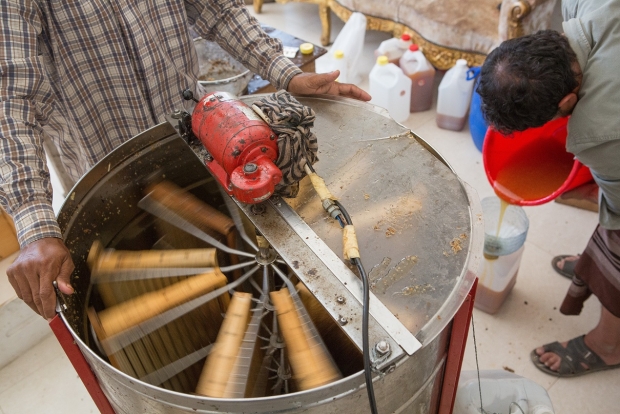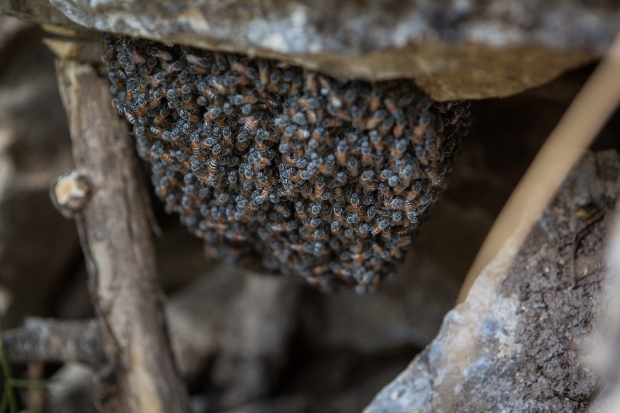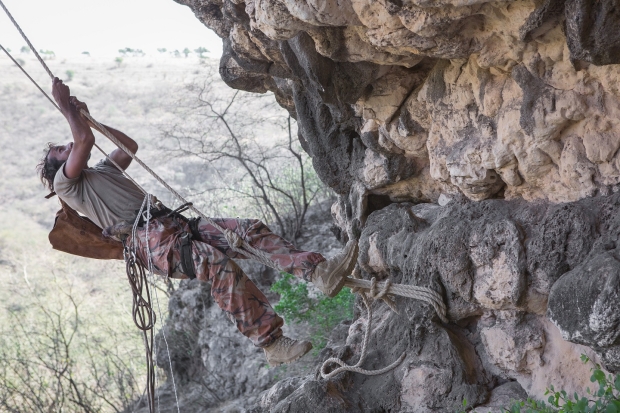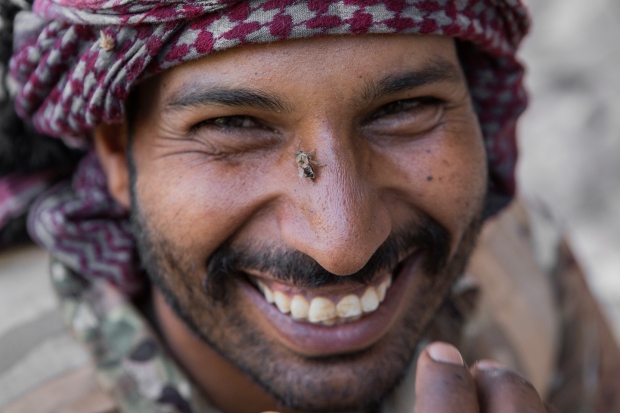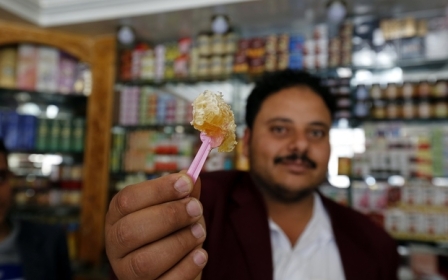Liquid gold: The price of Oman's sweet success

RUSTAQ AND SALALAH, Oman - Surrounded by thousands of buzzing bees amid the spectacular mountain scenery of Oman's Jebel Shams, Moosa Salim Mohammed al-Hamrashdi is collecting honey from a dozen hollowed out trunks of palm trees.
In this traditional method of Omani beekeeping, the beehive is placed in the hollowed-out trunk of a palm tree, which creates a unique flavour of honey but also protects the bees from both the summer heat and the cold in the winter season.
The wood scent from the palm trunk permeates the honey, creating a unique flavour.
Twice a year, from March to May and September to December, Hamrashdi, 48, harvests honey according to a method that he learned from his father.
New MEE newsletter: Jerusalem Dispatch
Sign up to get the latest insights and analysis on Israel-Palestine, alongside Turkey Unpacked and other MEE newsletters
Destined for local markets, the precious golden liquid is traditionally bottled by Omani farmers in recycled glass Vimto bottles, a beverage of choice during the month of Ramadan in the Arabian Peninsula.
Seated in a circle around their father in the living room, Hamrashdi's four children savour freshly made Sidr honey while listening to his vivid tales.
“My two sons will perpetuate our traditions,” he says in an outburst of pride.
But the tradition is dying. The family is one of the last among the surrounding villages to keep alive the ancient technique, down from a hundred less than five decades ago.
Other Omanis, increasingly busy with the hectic pace of a modern lifestyle, have shifted to standardised beehives that are easier to operate and consequently less time-consuming. “Myself I am a sergeant in the Royal Army. I commit to beekeeping; still, my dad used to offer a lot more time to his bees,” he says.
The threat from Egypt
According to Ali al-Wahaibi, a professor of beekeeping at Sultan Qaboos University, the almost systematic recourse to modern beehives made of wood or plastic has led to higher honey production. It has coincided with a money-oriented mindset since the new techniques were first introduced in Oman in the 1970s.
Most of the 5,000 beekeepers who operate across the country today opt for this more economically efficient method of keeping beehives. But that has come at a heavy price.
“Some of our collective knowledge in terms of traditional beekeeping have been lost," Wahaibi told MEE.
Even worse, beekeepers seeking a short-term return on investment started to import Egyptian bees on a large scale during the last 10 years. Although more robust than the native species, these bees carry new types of pests. Their eventual hybridisation with the Omani species will threaten the native bees in the long run.
“Our Ministry of Agriculture does not implement any regulations to prevent Egyptian bees from being imported into Oman,” Wahaibi says.
Furthermore, the Varroa destructor, a major pest of honey bees that feeds on their blood, has wreaked havoc in Oman. No accurate research has been conducted on the geographical spread, but it has decimated numerous bee colonies, says Wahaibi.
Finally, a significant decrease in the pattern of rainfall is drying the soil and reducing flora, forcing many beekeepers to provide bees with artificial food, such as syrup or sugar.
The last bee-hunters of Dhofar
Suspended 20 metres above the ground, Mohammed Salem Guwas al-Kathery, 35, explores the cavities of a rocky mountain in Wadi Sheer in Oman's southern Dhofar governorate. Without any protective clothing, and secured by a rope which his ancestors lacked, he collects honey, bare-handed, from natural hives.
“Bee-hunting remains a dangerous profession, sometimes you come across a snake coming out of a hole and bees can also sting you in the face,” he says.
A bee hunter for 15 years, the muscular man learnt the skill from his father who worked in this field for decades. “He taught me this old tradition to perpetuate it,” he explains. In spite of teaching his son how to collect wild honey, Kathery says that this ancient tradition will one day "completely disappear".
Less affected by the rampant modernisation of lifestyles, the southern governorate of Dhofar is nevertheless no longer a haven for bee hunters. “In 1997, those mountains were blessed with honey and I collected 42 bottles from a single place. Now, I harvest no more than two bottles a month."
In the crowded alleys of the Central Market of Salalah, Dhofar’s capital city, Ahmad Jabali sells honey collected from the mountain at a hefty $260 for one bottle. The natural liquid is served with food but also used for its therapeutic powers.
In Oman, Frankincense, Acacia and Sidr honey are the most common types available for sale. However, some beekeepers import cheap sugary honey made in China before bottling it in Vimto to mislead consumers, Jabali claims.
Among the 5,000 honey makers in operation in Dhofar Governorate, only 60 stick to traditional techniques while others have shifted to modern boxes for hives.
According to the Ministry of Agriculture, the number of beekeepers in Dhofar is expected to boom to 800 within three years as people are getting more aware of the business opportunity.
According to statistics, there were 5,000 beekeepers in Oman in 2016, selling honey for $39.5m a year, for an average turnover of $7,900.
Bees equal big business
But not everyone is critical of the modern ways of beekeeping: local officials, who want to diversify Oman’s economy from its reliance on hydrocarbons, praise the same methods vigorously criticised by Ali al-Wahaibi.
“We support a shift from ancestral techniques towards modern beehives that produce more,” Ahmed Hassan Kashoob, head of the honey division at the Ministry of Agriculture in Salalah told MEE.
Run by the ministry's honey division, a 10-day training course attended by 150 Omanis in 2018 is helping less-educated populations to access employment by running apiaries. It's hoped it will play a small part in alleviating Oman's severe jobs crisis, which sparked demonstrations across the country earlier this month.
This pro-active government strategy to encourage honey production is paying off as the number of beekeepers has increased by 90 percent since 2011 to produce 600 tonnes of honey a year, part of which is exported to member states of the Gulf Cooperation Council and beyond.
This internationalisation means packaging will be increasingly standardised to comply with international standards. The Vimto bottle could disappear. But this economic expansion of the honey business could also threaten an end to the era of artisanal honey-making in the Sultanate of Oman.
“People used to see beekeeping as a tradition," says Kashoob. "Now it is a business."
Middle East Eye delivers independent and unrivalled coverage and analysis of the Middle East, North Africa and beyond. To learn more about republishing this content and the associated fees, please fill out this form. More about MEE can be found here.




